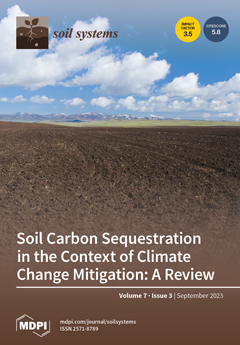Water and salt stresses are among the most important global problems that limit the growth and production of several crops. The current study aims at the possibility of mitigating the effect of deficit irrigation of common bean plants growing in saline lands by foliar spraying with selenium via the assessment of growth, productivity, physiological, and biochemical measurements. In our study, two field-based trials were conducted in 2017 and 2018 to examine the influence of three selenium (Se) concentrations (0 (Se
0), 25 (Se
25), and 50 mg L
−1 (Se
50)) on common bean plants grown under full irrigation (I
100 = 100% of the crop evapotranspiration; ETc) and deficit irrigation (I
80 = 80% of ETc, and I
60 = 60% of ETc). Bean plants exposed to water stress led to a notable reduction in growth, yield, water productivity (WP), water status, SPAD value, and chlorophyll
a fluorescence features (Fv/Fm and PI). However, foliar spraying of selenium at 25 or 50 mg L
−1 on stressed bean plants attenuated the harmful effects of water stress. The findings suggest that foliage application of 25 or 50 mg L
−1 selenium to common bean plants grown under I
80 resulted in a higher membrane stability index, relative water content, SPAD chlorophyll index, and better efficiency of photosystem II (Fv/Fm, and PI). Water deficit at 20% increased the WP by 17%; however, supplementation of 25 or 50 mg L
−1 selenium mediated further increases in WP up to 26%. Exogenous application of selenium (25 mg L
−1 or 50 mg L
−1) to water-stressed bean plants elevated the plant defense system component, given that it increased the free proline, ascorbic acid, and glutathione levels, as well as antioxidant enzymes (SOD, APX, GPX, and CAT). It was concluded that the application of higher levels (25 or/and 50 mg L
−1) of Se improves plant water status as well as the growth and yield of common beans cultivated in saline soil.
Full article





